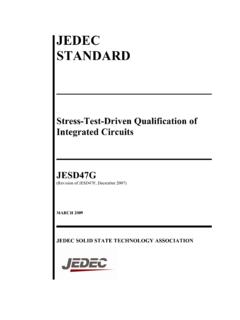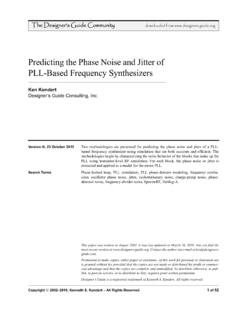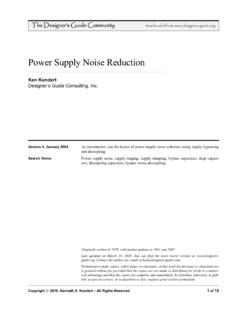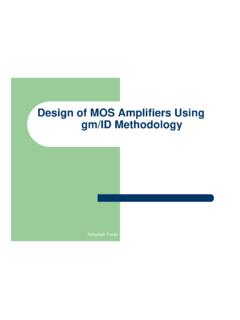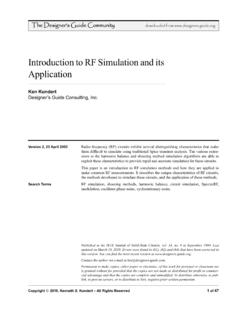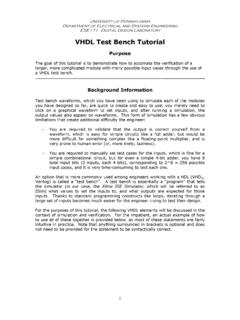Transcription of A Test Bench for Differential Circuits - Designer’s Guide
1 The Designer s Guide Communitydownloaded from 2002-2019, Kenneth S. Kundert All Rights Reserved1 of 7 Version 1e, 28 November 2018 Introduces a new test Bench constructed using ideal baluns that makes the simulation of Differential Circuits easier and less error TermsSimulating Differential Circuits , Differential testbench, ideal updated on March 10, 2019. You can find the most recent version at Contact the author via e-mail at to make copies, either paper or electronic, of this work for personal or classroom use is granted without fee provided that the copies are not made or distributed for profit or commer-cial advantage and that the copies are complete and unmodified.
2 To distribute otherwise, to pub-lish, to post on servers, or to distribute to lists, requires prior written s Guide is a registered trademark of Kenneth S. Kundert. All rights Test Bench for Differential CircuitsKen KundertDesigner s Guide Consulting, Test Bench for Differential CircuitsThe Traditional Test Bench2 of 7 The Designer s Guide The Traditional Test BenchConsider the test Bench shown in Figure test Bench , or some variation of it, is commonly used when simulating Differential Circuits . While it does generally get the job done, it has a number of short comings. First, driving the device-under-test, or DUT, with a purely Differential input requires that the stimulus be applied from two sources, Vdm1 and Vdm2.
3 Doing so is somewhat of a bother, and represents a potential source of error. If the stimulus is only applied to one source, or if the stimuli are applied differ-ently from both sources, then the signals that drive the DUT will contain an undesired common-mode component that can cause erroneous results. In addition, determining the Differential output signal requires measuring a floating voltage, again this is somewhat of a bother because many waveform viewing tools do not make displaying floating sig-nals as easy as they should. The Differential source impedance seen by the DUT is Rin1 + Rin2 and the common-mode source impedance is Rin0 + Rin1 || Rin2. Similarly, the Differential load impedance seen by the DUT is Rout1 + Rout2 and the common-mode load impedance is Rout0 + Rout1 || Rout2.
4 Thus, controlling the source and load impedance involves setting several resis-tor values. To maintain Differential symmetry, one must always assure that Rin1 = Rin2 and Rout1 = Rout2. Again, maintaining these relationships is both a bother, and a poten-tial source of errors. In addition, there is a lower bound on the common-mode imped-ances that is set by Rx1 || test Bench is improved somewhat in Figure 2. In this case, the negative input to the amplifier is created using a controlled source that mimics the voltage on the positive input. In this way, to specify a Differential input you only need set the voltage on one source, which reduces the effort needed to adjust in the input and reduces the chance of error.
5 In addition, the floating output voltage is converted to a ground-referred signal with a controlled source. This addresses some of the issues of the test Bench of Figure 1, but not all. In particular, you would have to specify the input on the Differential sources as half the desired Differential input voltage, a possible source of confusion and error. In addition, while a ground-referred version of the Differential output voltage is now avail-able, one would still have to go through the trouble of making Differential measurements for the common-mode output voltage as well as the input voltages and both the input and output currents if they were desired. FIGURE test set-up used when simulating a Differential amplifier.
6 + + + + VcmVdm1 Vdm2 Rin1 Rin2+ Rout2 Rout1 Rout0 Rin0 DUTThe New Test BenchA Test Bench for Differential Circuits3 of 7 The Designer s Guide The New Test BenchImagine that instead of constructing a test Bench for Differential Circuits using a combi-nation of simple resistors and voltage sources as in Figure 1, that one had an ideal block that maps between two distinct ground-referred signals and a balanced pair of signals. The two distinct signals would represent the Differential - and common-mode compo-nents of the balanced signals. Thus, if vd and vc represent the distinct signals represent-ing the Differential - and common-mode components, and vp and vn make up the balanced pair of signals, then Differential -mode voltagevd = vp vn(1)common-mode voltagevc = (vp + vn)(2)positive voltagevp = vc + vd(3)negative voltagevn = vc vd(4)Now, while we are dreaming, lets further imagine that the block does a similar mapping for the currents, and sodifferential-mode currentid = (ip in)(5)common-mode currentic = ip + in(6)positive currentip = ic + id (7)negative currentin = ic id (8)
7 These voltages and currents are shown in Figure improved test set-up for simulating a Differential voltages and currents.+ + + VcmVdm1 Vdm2=Vdm1 Rin1 Rin2+ Rout2 Rout1 Rout0 Rin0 DUT+ + Voutd= vodvodpndcvpvdvcvnipinidicA Test Bench for Differential CircuitsThe New Test Bench4 of 7 The Designer s Guide that In these equations, ip and in defy normal convention and are positive as they exit their pins so that the current at one side of the balun matches the direction at the other side. It may surprise you that the voltage and current definions differ by a factor of two, but these are the natual definitions. They result in the power entering on one side of the balun matching that leaving on the other side [1].
8 With such a component, a test Bench could be created for a Differential circuit that allows you to easily create Differential - and common-mode stimuli, probe Differential - and common-mode responses, and set the Differential - and common-mode source and load impedances. Such a test Bench is shown in Figure balanced/unbalanced converter, or balun, can be constructed with two ideal trans-formers, as shown in Figure 5. The implementation of an ideal balun using a Spectre1 subcircuit is given in Listing 1, and using a SPICE subcircuit is given in Listing 2. From within the Cadence Analog Design Environment, the ideal balun was made available in analogLib (ideal_balun) in the 2002 time frame.
9 Notice that the balun is bidirectional. Either the unbalanced signals (d for Differential mode and c for common mode) or the balanced signals (p for positive and n for nega-tive) can act as the inputs or the outputs. This means that the same circuit is used at the input of a Differential amplifier to convert the stimuli to the balanced form needed to drive the amplifier, and at the output to separate the balanced output into distinct differ-FIGURE test Bench for Differential Spectre is a registered trademark of Cadence Design balun for converting ground-referred Differential -mode (d) and common-mode (c) signals to balanced positive (p) and negative (n) signals. Ideal transformers are used, and so the balun works and is accurate at all frequencies, including + + + DUTpndcpndcRid+ VcmRicRodRocPCDN2:12:1 The New Test BenchA Test Bench for Differential Circuits5 of 7 The Designer s Guide and common-mode signals for easy measurement.
10 Furthermore, since it is implemented with ideal transformers the balun works for all frequencies, including DC. This is a feat that is not possible using real this test Bench , driving the DUT with a Differential stimulus only requires setting the stimulus on one source. Similarly, the Differential - and common-mode input and out-put voltages and currents can all be observed by probing at one point. Finally, one con-trols the Differential - and common-mode source and load impedances by specifying the value of a single resistor for each, and they are completely independent of each for Spectre implemented using ideal BALUN // // A bidirectional balanced-unbalanced converter. // Maps between the unbalanced signals d and c and the balanced signals p and n.
